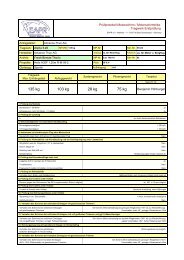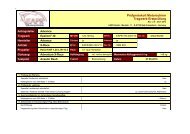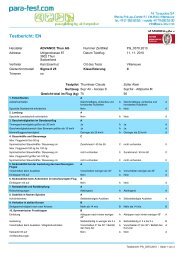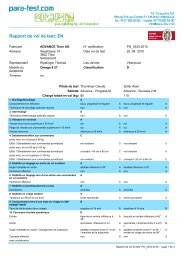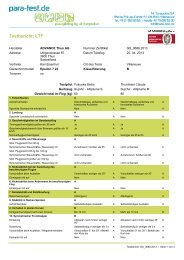Create successful ePaper yourself
Turn your PDF publications into a flip-book with our unique Google optimized e-Paper software.
Take off :<br />
The BI BETA 2 is suited to forward and reverse inflations. Lay the canopy out so as to maintain<br />
its elliptical form at the leading edge. Hold the risers below the large quick link then advance<br />
until the suspension lines are under light tension. Position yourself in a central position relative<br />
to the canopy. At the start of take off, gently accelerate and guide the risers until the canopy is<br />
above the head, without either pulling down or pushing the risers exessively forward. The canopy<br />
rises progressively without any «hard point». The canopy will cease to rise if not guided by<br />
the risers. The BI BETA 2 inflates easily and rises without any overshooting.<br />
Normal flight :<br />
The BI BETA 2 achieves «best glide» with brakes in the hands up position. Lightly applying brakes<br />
will reduce the sink rate. When flying through turbulence the application of a small amount<br />
of brake will increase stability.<br />
Turns :<br />
The BI BETA 2 will respond to brake application in an immediate and proportional manner to<br />
the amount of brake applied. To familiarise yourself with this make your first turns in a gradual<br />
and progressive manner. To make the most efficient turns in thermal conditions, having found<br />
the core of the thermal we advise you to fly with approx 30% brakes and to control the radius<br />
of your circle with the inside brake; it is unnecessary to release the outside brake. The <strong>Advance</strong><br />
harness helps give the BI BETA 2 its good stability.<br />
Symmetrical or assymmetrical collapses :<br />
The BI BETA 2 conveys a highly satisfying solid feel. An active flying style will virtually eliminate<br />
collapses. Larger collapses (over 50%) are characterised by a reasonably dynamic turn which is<br />
easily controlled. For these situations we recommend the following : weight shift to the open<br />
side, try to rotate with any ensuing turn so as to reduce the potential for a twist. This also maintains<br />
airspeed and internal pressure promoting a fast reopening. Depending on the severity of<br />
the turn apply brake on the open side so as not to enter a spiral dive but be aware of creating a<br />
potential stall. The object is to fly the glider in a desirable direction (avoiding obstacles) and<br />
then reopen the collapsed side using a generous pumping action.<br />
43



